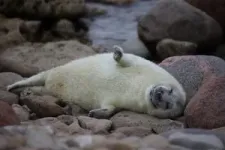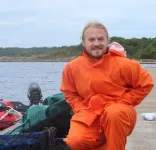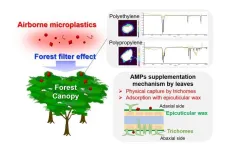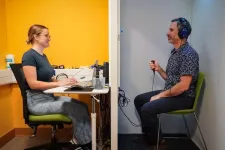(Press-News.org) Researchers at the University of Gothenburg warn that today's hunting quotas of about 3,000 animals pose a risk to the long-term survival of the grey seal in the Baltic Sea. The conclusions of this new study are based on statistics from 20th century seal hunting and predictions of future climate change.
After decades of hard hunting and environmental contamination by toxins such as PCBs, there were only 5,000 grey seals left in the entire Baltic Sea by the 1970s, falling from an initial size of more than 90,000 at the beginning of the century. Since then, the population has partially recovered, and today stands at around 55,000 animals for all countries combined.
Baltic grey seals are genetically isolated from the closest grey seal populations in the Atlantic. They are generally slightly smaller and, unlike solely land breeding seals found in the British Isles, can give birth to young on both drift ice and on land. The population is now facing new challenges in a world with a warming climate and a shortage of appropriately sized prey fish. Using a mathematical model, the researchers showed that increased seal hunting could cause the population to decline once more.
"It has taken three generations for the grey seal to recover. The seal population is now growing, but our research shows that, if the current hunting quota of 3,000 animals per year is met, the survival of the grey seal in the Baltic Sea will once again be threatened," says Daire Carroll, Associate researcher at the University of Gothenburg and lead author of the study published in the Journal of Animal Ecology.
At present, about 1,500 seals are killed each year in the Baltic Sea.
The hunting quota must be reduced
The researchers created a mathematical model for grey seal population growth and examined several different scenarios for the future. They tested the effect of different hunting pressures, different levels of food availability, and the consequences of less sea ice.
"We saw that killing 3,000 seals each year always led to a decrease in seal population size, even in the most optimistic scenarios for the climate and marine environment. Our conclusion is that the current hunting quota in the Baltic Sea is unsustainable. If the seal population is to continue to recover, the maximum number that can be hunted is 1,900 animals. But if there are other environmental changes that have a negative impact on population, that figure should also be reduced," says Daire Carroll.
The countries around the Baltic Sea have agreed that the grey seal population should be allowed to recover after coming close to extinction in the 20th century due to hunting and environmental contamination. Conflict with fisheries during this period led to a bounty on seals. A biproduct of this is that there are detailed statistics on how many seals were killed each year. Researchers at the University of Gothenburg were helped by their colleagues at the Swedish Museum of Natural History in Stockholm to produce data on the development of the grey seal in modern times. Thanks to the fact that seals are now used as an environmental indicator for the Baltic Sea, there is good data on the seals' numbers, fertility, and health.
Advantage of breeding on ice
"We created a model of how the seal population would have grown over the last 20 years if there had been no hunting. In this way, we can estimate the long-term effect of today's hunting quotas on the seal population. We have also simulated what a warmer climate would mean for the grey seal," says Daire Carroll.
Baltic grey seal pups have a greater chance of survival if they are born on sea ice instead of on land. On ice floes, mothers and pups can spread out over a larger area and the pups face fewer threats from other predators, humans, or infections that are easily spread in dense seal colonies on land.
As the seal population has grown, so has the conflict with the fishing industry, and in 2020, the protective hunt was supplemented with a licensed hunt in Finland and Sweden. In total, more than 3,000 animals could potentially be killed.
"The culling of individual seals that visit or destroy fishing gear has always been allowed and is not problematic for the survival of the population. It was a few hundred individuals per year and did not affect entire groups of seals. But the new licensed hunting, it is different, it risks hitting the survival of the grey seal hard," says Karin Hårding, Professor of Ecology at the University of Gothenburg and co-author of the study, who has been researching seals since the late 1980s.
Researchers at the University of Gothenburg warn that today's hunting quotas of about 3,000 animals pose a risk to the long-term survival of the grey seal in the Baltic Sea. The conclusions of this new study are based on statistics from 20th century seal hunting and predictions of future climate change.
After decades of hard hunting and environmental contamination by toxins such as PCBs, there were only 5,000 grey seals left in the entire Baltic Sea by the 1970s, falling from an initial size of more than 90,000 at the beginning of the century. Since then, the population has partially recovered, and today stands at around 55,000 animals for all countries combined.
Baltic grey seals are genetically isolated from the closest grey seal populations in the Atlantic. They are generally slightly smaller and, unlike solely land breeding seals found in the British Isles, can give birth to young on both drift ice and on land. The population is now facing new challenges in a world with a warming climate and a shortage of appropriately sized prey fish. Using a mathematical model, the researchers showed that increased seal hunting could cause the population to decline once more.
"It has taken three generations for the grey seal to recover. The seal population is now growing, but our research shows that, if the current hunting quota of 3,000 animals per year is met, the survival of the grey seal in the Baltic Sea will once again be threatened," says Daire Carroll, Associate researcher at the University of Gothenburg and lead author of the study published in the Journal of Animal Ecology.
At present, about 1,500 seals are killed each year in the Baltic Sea.
The hunting quota must be reduced
The researchers created a mathematical model for grey seal population growth and examined several different scenarios for the future. They tested the effect of different hunting pressures, different levels of food availability, and the consequences of less sea ice.
"We saw that killing 3,000 seals each year always led to a decrease in seal population size, even in the most optimistic scenarios for the climate and marine environment. Our conclusion is that the current hunting quota in the Baltic Sea is unsustainable. If the seal population is to continue to recover, the maximum number that can be hunted is 1,900 animals. But if there are other environmental changes that have a negative impact on population, that figure should also be reduced," says Daire Carroll.
The countries around the Baltic Sea have agreed that the grey seal population should be allowed to recover after coming close to extinction in the 20th century due to hunting and environmental contamination. Conflict with fisheries during this period led to a bounty on seals. A biproduct of this is that there are detailed statistics on how many seals were killed each year. Researchers at the University of Gothenburg were helped by their colleagues at the Swedish Museum of Natural History in Stockholm to produce data on the development of the grey seal in modern times. Thanks to the fact that seals are now used as an environmental indicator for the Baltic Sea, there is good data on the seals' numbers, fertility, and health.
Advantage of breeding on ice
"We created a model of how the seal population would have grown over the last 20 years if there had been no hunting. In this way, we can estimate the long-term effect of today's hunting quotas on the seal population. We have also simulated what a warmer climate would mean for the grey seal," says Daire Carroll.
Baltic grey seal pups have a greater chance of survival if they are born on sea ice instead of on land. On ice floes, mothers and pups can spread out over a larger area and the pups face fewer threats from other predators, humans, or infections that are easily spread in dense seal colonies on land.
As the seal population has grown, so has the conflict with the fishing industry, and in 2020, the protective hunt was supplemented with a licensed hunt in Finland and Sweden. In total, more than 3,000 animals could potentially be killed.
"The culling of individual seals that visit or destroy fishing gear has always been allowed and is not problematic for the survival of the population. It was a few hundred individuals per year and did not affect entire groups of seals. But the new licensed hunting, it is different, it risks hitting the survival of the grey seal hard," says Karin Hårding, Professor of Ecology at the University of Gothenburg and co-author of the study, who has been researching seals since the late 1980s.
END
Scientists warn: The grey seal hunt is too large
2024-03-27
ELSE PRESS RELEASES FROM THIS DATE:
Small Aussie mammal's bite 'packs a punch'
2024-03-27
Australian rock-wallabies are ‘little Napoleons’ when it comes to compensating for small size, packing much more punch into their bite than larger relatives.
Researchers from Flinders University made the discovery while investigating how two dwarf species of rock-wallaby are able to feed themselves on the same kinds of foods as their much larger cousins.
Study leader Dr Rex Mitchell also coined the idea of ‘Little Wallaby Syndrome’ after examining the skulls of dwarf rock-wallabies to discover they can more than compensate for their size.
“We already knew that ...
Advancing towards sustainability: turning carbon dioxide and water into acetylene
2024-03-27
Reaching sustainability is one of humanity’s most pressing challenges today—and also one of the hardest. To minimize our impact on the environment and start reverting the damage humanity has already caused, striving to achieve carbon neutrality in as many economic activities as possible is paramount. Unfortunately, the synthesis of many important chemicals still causes high carbon emissions.
Such is the case of acetylene (C2H2), an essential hydrocarbon with a plethora of applications. This highly ...
Twist of groundwater contaminants
2024-03-27
In recent years, the world has been experiencing floods and droughts as extreme rainfall events have become more frequent due to climate change. For this reason, securing stable water resources throughout the year has become a national responsibility called 'water security', and 'Aquifer Storage Recovery (ASR)', which stores water in the form of groundwater in the ground when water resources are available and withdraws it when needed, is attracting attention as an effective water resource management technique.
The Korea Institute of Science and Technology (KIST) announced that a team of Dr. Seunghak ...
Scientists extract genetic secrets from 4,000-year-old teeth to illuminate the impact of changing human diets over the centuries
2024-03-27
Researchers at Trinity College Dublin have recovered remarkably preserved microbiomes from two teeth dating back 4,000 years, found in an Irish limestone cave. Genetic analyses of these microbiomes reveal major changes in the oral microenvironment from the Bronze Age to today. The teeth both belonged to the same male individual and also provided a snapshot of his oral health.
The study, carried out in collaboration with archaeologists from the Atlantic Technological University and University ...
Treatment of advanced non-small cell lung cancer with driver mutations
2024-03-27
Lung cancer is the leading cause of cancer-related death worldwide. Improved understanding of driver mutations of non-small cell lung cancer (NSCLC) has led to more biomarker-directed treatment for patients with advanced stages. The expanding number of drugs targeting these driver mutations offers more opportunity to improve patient’s survival benefit.
To date, NSCLCs, especially those with non-squamous histology, are recommended for testing epidermal growth factor receptor (EGFR) mutations, anaplastic lymphoma kinase (ALK) gene rearrangements, ROS proto-oncogene receptor tyrosine kinase 1 (ROS-1) rearrangements, B-raf proto-oncogene (BRAF) mutations, rearranged during transfection ...
UK rabbit owners can recognize pain in their pets, study finds
2024-03-27
Rabbits are popular family pets, with around 1.5 million* in the UK and it is important that owners can recognise when their animal is in pain, and know when to seek help to protect their rabbit’s welfare. New research by the University of Bristol Veterinary School has found the majority of rabbit owners could list signs of pain and could mostly identify pain-free rabbits and those in severe pain, but many lacked knowledge of the subtler sign of pain.
The study, published in BMC Veterinary Research today [27 March], provides the first insight into how rabbit owners identify pain and their general ability to apply this knowledge to detect pain ...
World's first demonstration that forests trap airborne microplastics
2024-03-27
A research group led by Japan Women’s University finds that airborne microplastics adsorb to the epicuticular wax on the surface of forest canopy leaves, and that forests may act as terrestrial sinks for airborne microplastics
Tokyo, Japan – Think of microplastics, and you might think of the ones accumulating in the world’s oceans. However, they are also filling the sky and the air we breathe. Now, it has been discovered that forests might be acting as a sink for these airborne microplastics, offering humanity yet another ...
How will you age? World-leading Dunedin Study launches next phase
2024-03-27
The world-leading Dunedin Study is set to launch its age 52 assessments, delving into an understudied but important period of life and time of change.
The Dunedin Multidisciplinary Health and Development Study is a longitudinal study that follows the lives of 1037 babies born in Queen Mary Maternity Hospital between 1 April 1972 and 31 March 1973. It is the most detailed study of human health and development in the world.
Members have been assessed regularly throughout their lives, most recently at age 45.
Study Director, Research Professor Moana Theodore is incredibly excited ...
Opportunistic emergency department stop smoking prompt helps smokers quit
2024-03-27
An opportunistic emergency department stop smoking prompt, comprising brief advice by a trained professional, an e-cigarette starter kit, and referral to local stop smoking services can help smokers quit, with a significant proportion of them still not smoking 6 months later, finds research published online in Emergency Medicine Journal.
Some 6.4 million people in the UK still haven’t stubbed out for good, and of the large numbers of people attending emergency departments, a substantial proportion are more likely to be smokers and have poorer overall health, explain ...
Consistently exercising 2-3 times a week over the long term linked to lower current insomnia risk
2024-03-27
Consistently exercising 2-3 times a week over the long term is linked to a lower current risk of insomnia as well as the ability to clock up the recommended 6-9 hours of shut eye every night, suggests an international 10-year study published in the open access journal BMJ Open.
Regular exercise is associated with better overall health, and several studies have suggested that physical activity promotes better quality sleep and may improve symptoms of chronic insomnia, note the researchers.
But it’s not entirely clear how much gender, age, weight (BMI), overall fitness, general health and exercise ...








